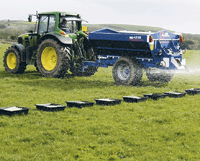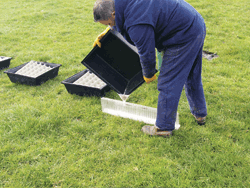Fertiliser spreader tests prove cost effective

A simple test determining the accuracy of fertiliser spreaders can help dairy farmers save on their input costs – and improve their pastures, too.
While arable farmers have long seen the sense in investing in an annual test for their spreaders, dairy producers have largely been slow to recognise the benefits.
But as the cost of chemical fertiliser has increased, testing makes financial sense, says Staffordshire milk producer Mark Swift.
He pays a company to service his spreader and calibrate the settings once a year. A set of trays, spaced in intervals to a set formula in a field, collects fertiliser as a spreader moves down the centre of these trays. The spread pattern is determined by pouring the fertiliser collected in these trays into test tubes.
Once a spread pattern is evaluated, the necessary adjustments can be made or more significant problems detected. The volume of fertiliser in the tubes provides a quick, visible evaluation of the spread pattern. If the spread pattern is uniform across the bout width, and the proper width is used, the material will be deposited uniformly on the land. A mathematical formula is used to determine the extent of the inaccuracy if the spread pattern is not the same either side.
Running a herd of 320 cows at Red House Farm, near Stafford, Mr Swift knew his spreader was inaccurate because he noticed striping in his pastures. And according to experts, if striping is visible then a field is losing 25% of its potential output.
Mr Swift needed to confirm the accuracy of fertiliser application for Farm Assurance purposes so he engaged a company to check his spreader.

“When we first had the machine tested there was enough of a difference for us to be glad we had done it, it was out on width. Ever since we have been having it tested I would say we have improved accuracy by up to 10%,” he says.
Mr Swift is paying between £245 and £255/t for fertiliser and says the test costs him the equivalent of one tonne. He reckons he is not only saving on product, but there has been a definite improvement in his pastures. “The colour is improved and the growth pattern is more even,” he says.
Calibration checks on spreaders should show the type of spread pattern, including the degree of uniformity across the swath, the effective swath width and the rate of application.
Specialist spray testers Rob Foxhall, of Spreaders and Sprayers Testing, Staffordshire, reckons the British farming industry loses millions of pounds every year through inaccurate spreading of fertiliser because of waste, loss of yield and environmental damage.
He says if the spreader is correctly calibrated, the performance of the machine is maximised and yields are enhanced, which equate to better financial returns.
Before the test is carried out, the spreader is given an MOT. Mr Foxhall reckons about three-quarters of the machines his company tests need some form of alteration.
“It might be something basic like the veins might need changing, but we wouldn’t take the machine out into the field if we didn’t think it was fit to spread,” he says.
The tests often reveal a combination of problems, says Mr Foxhall. “Perhaps the spreader is spreading too far or not far enough or there might be an unbalanced spread pattern with more being thrown out one side than the other.”
The evidence gathered during the test is used to determine what alterations are needed. Once this has been done the machine is retested.
“We use industry standard figures to produce a graph confirming the accuracy or inaccuracy of the spread. We would be aiming for a co-efficiency variation of less than 10%,” says Mr Foxhall.
He says many of his customers do their own tray tests between an annual check, but regard a test by a professional company as essential. “Farmers can do their own tray test but I have always likened it to when I was in college and I was put in charge of the milking parlour for a week. Yes, the cows were milked, but they wouldn’t have put me in charge of the herd for a year. A professional knows how a machine should be performing and, if there are inaccuracies, how to put those right,” he says.
